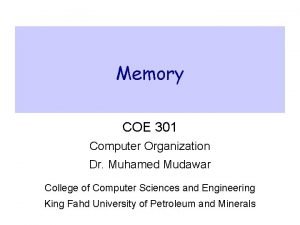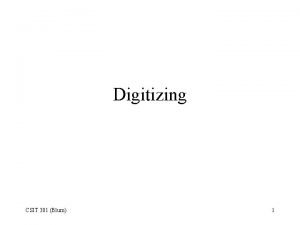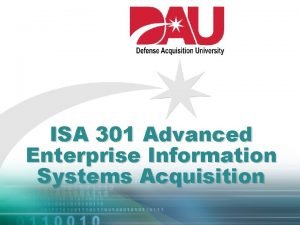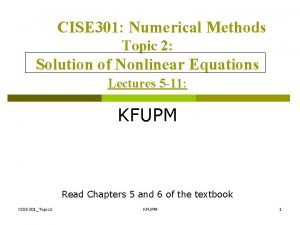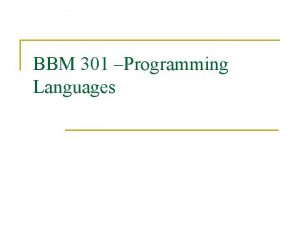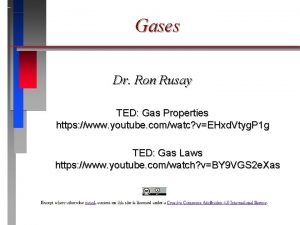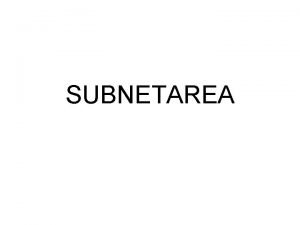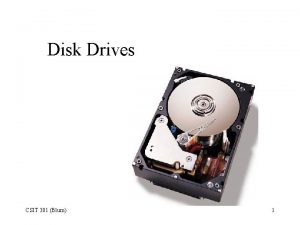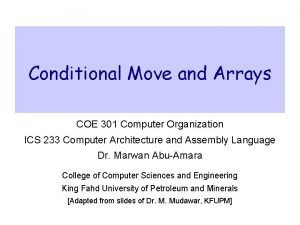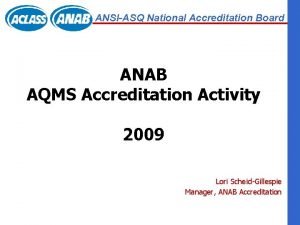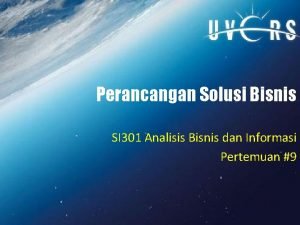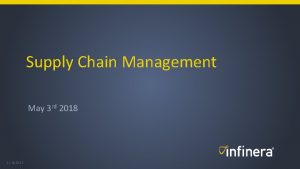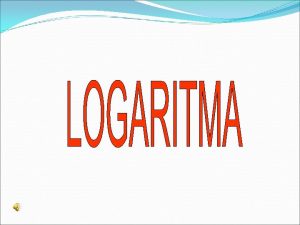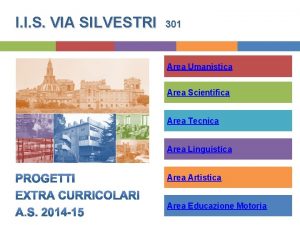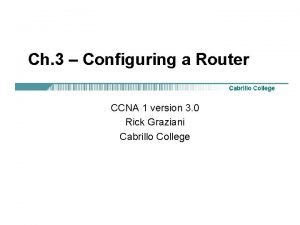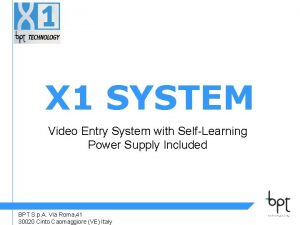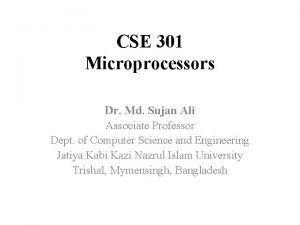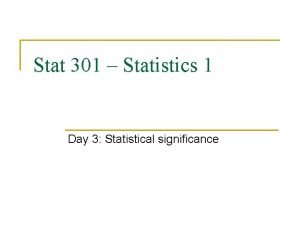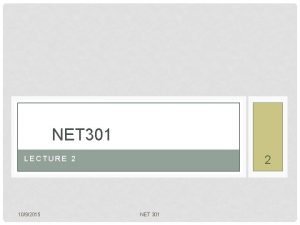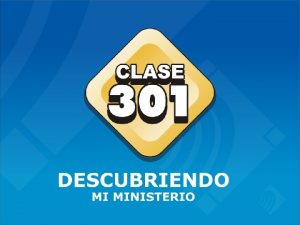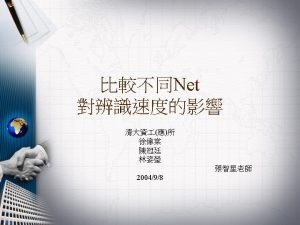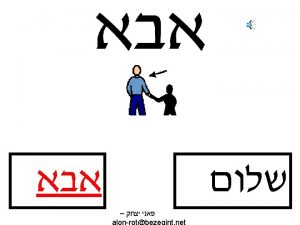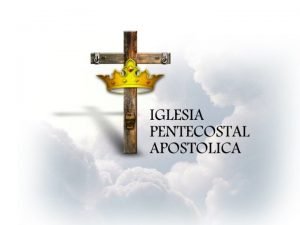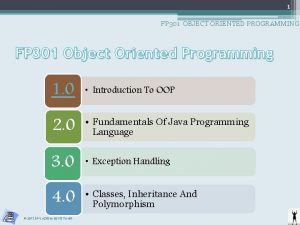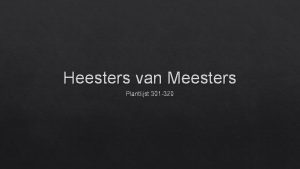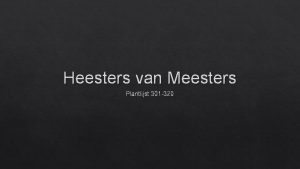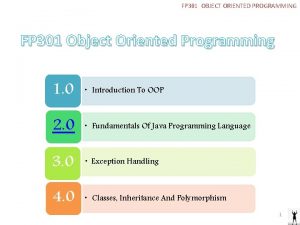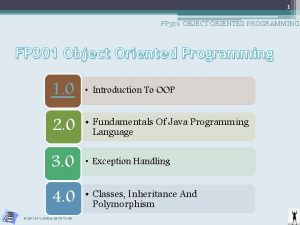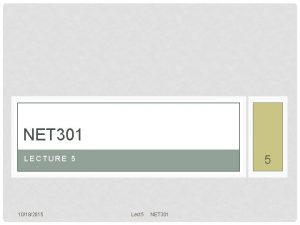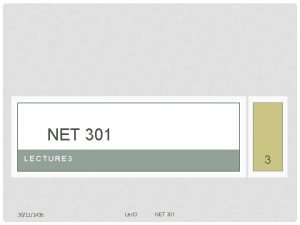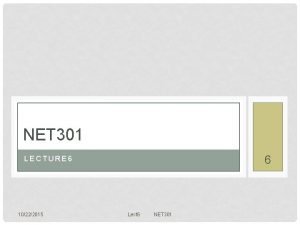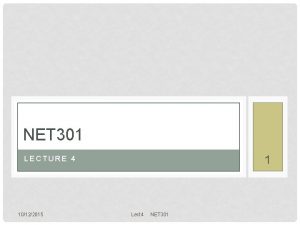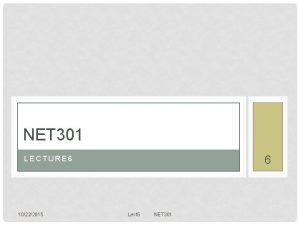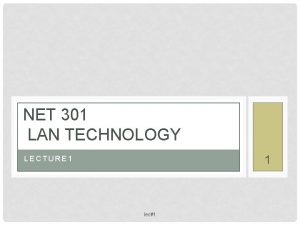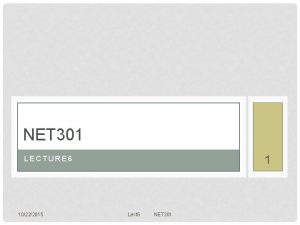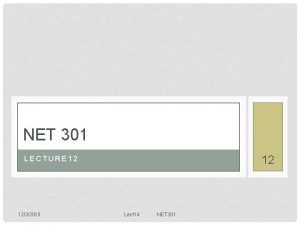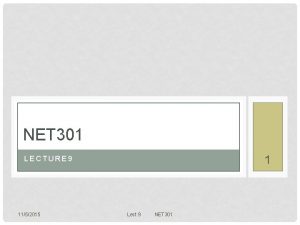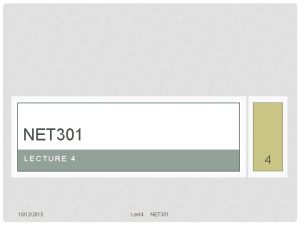NET 301 1 LECTURE 2 1092015 NET 301



























- Slides: 27

NET 301 1 LECTURE 2 10/9/2015 NET 301

STANDARD MODELS: • OSI Model : Open system Interconnection. • is a conceptual model that characterizes and standardizes the internal functions of a communication system by partitioning it into abstraction layers. The model is a product of the Open Systems Interconnection project at the International Organization for Standardization (ISO) 10/9/2015 NET 301 2

STANDARD MODELS: • Layered Model: The model groups similar communication functions into one of seven logical layers • • • Change. Design. Learning. Troubleshooting. Standards. 10/9/2015 NET 301 3

ISO MODEL • Physical Layer: • Physical interface between devices • Handle transmission of bits over communication channel. • Choice of wired or wireless medium. • Data is converted into signals • Include voltage level , connectors, media choice. • Modulation techniques • Its responsible the movement of individual bits from one node to another 10/9/2015 NET 301 4

10/9/2015 NET 301 5

ISO MODEL • Data Link Layer: • • • Transforms data into frame. Means of activating , maintaining and deactivating a reliable link. Error detection and control. Flow control. Higher layers may assume error free transmission. • Its responsible the movement of frames from one node to another 10/9/2015 NET 301 6

10/9/2015 NET 301 7

ISO MODEL • Network Layer: • Transport of information • Higher level do not need to know about underlying technology. • responsible for creating , maintaining and ending network connection. • Transfer a data packet from node within the network. • Routing • Its responsible the movement of individual packet from the source host to destination host. 10/9/2015 NET 301 8

10/9/2015 NET 301 9

• Transport layer. • • • Exchange of data between end system. (end to end flow control) Error free In sequence Quality of service. Layer 4 include transmission control protocol and user datagram protocol. • Its responsible the delivery of message from one process to another. 10/9/2015 NET 301 10

10/9/2015 NET 301 11

ISO MODEL • Session Layer: • • Control dialogue between applications Half duplex, full duplex. Synchronization points (back up point) Grouping • Its responsible dialog control and synchronization 10/9/2015 NET 301 12

ISO MODEL • Presentation Layer: • Data formats and coding • Data compression • Encryption • Its responsible translation , compression and encrytion 10/9/2015 NET 301 13

ISO MODEL • Application Layer: • Layer where the application using the network resides • Common network application include : remote login , file transfer, e-mail and web browsing • Means for application to access OSI environment. • Its responsible for providing the service for user. 10/9/2015 NET 301 14

10/9/2015 NET 301 15

LAN STANDARD MODEL • IEEE 802 standard model: • Four 4 main layers. • Physical Layer: • Electronic, Electrical, mechanical and procedural aspects of electrical signal of the data transmission. • Data Link Layer: That consists of two sub-layers: • Logical Link Control LLC. • Media Access Control MAC. 10/9/2015 NET 301 16

IEEE 802 MODEL: • Logical Link Control LLC protocol: • LAYER 2 USES LOGICAL LINK CONTROL(LLC) TO COMMUNICATE WITH THE UPPER-LEVEL LAYERS. • ESTABLISHMENT AND CONTROL LOGICAL LINK BETWEEN LOCAL DEVICES. • SYNCHRONIZATION ﺗﺤﺪﻳﺪ ﺳﺮﻋﺔ ﺍﻟﺘﺒﺎﺩﻝ ﺑﻴﻦ ﺍﻟﻮﺣﺪﺍﺕ • ERROR CONTROL • Medium Access Control MAC: • LAYER 2 USES MEDIA ACCESS CONTROL(MAC) TO DECIDE WHICH COMPUTER WILL TRANSMIT. • PROTOCOLS TO DATA ENTERING TO NETWORK MEDIA • MAC ADDRESSING. • COLLISION CONTROL. 10/9/2015 NET 301 17

IEEE 802 MODEL • Network Layer: • Routing data across network and from a network to another different one. • Other layers: • No rigid standard for the rest layers as it may vary from network to another one due to its functions and types. • They could be OSI upper layers or any other standard model layers. 10/9/2015 NET 301 18

OSI VS. IEEE 802 MODEL 10/9/2015 NET 301 19

LAN APPLICATIONS • Electronic Communication applications: • • • Cheap Fixable Effectiveness Remote access to data Access to data from different places( network devices) 10/9/2015 NET 301 20

LAN APPLICATIONS • Examples of Electronic Communication applications v. Email applications. v. Chatting applications. v. Audio and Video conferencing applications. v. Cyberspace conferencing. 10/9/2015 NET 301 21

LAN APPLICATIONS • Distributed data bases: • Data entered into a central datacenter or into a distributed databases then can be retrieved from varies local devices in the network. • Universities database. • Companies databases. 10/9/2015 NET 301 22

LAN APPLICATIONS • Distributed information systems: • systems that automate the operations of commercial enterprises such as banking and financial transaction processing systems, warehousing systems, and automated factories. • Communicates to central computers (governments, universities) to retrieve or process information. 10/9/2015 NET 301 23

LAN APPLICATIONS • Office automation and teamwork: • • Resource sharing: printers, storage. Reduce costs. Increase productivity Doing a collective work 10/9/2015 NET 301 24

LAN APPLICATION • Electronic transactions: • • • Facilitate administrative work Reporting systems Document editing and viewing Document signing Document transfers v. E-Business : for private business use v. E-Government: for government use 10/9/2015 NET 301 25

LAN APPLICATION • Process capabilities improving Applications: • More than one computer can work collaboratively to do complex and expensive tasks. 10/9/2015 NET 301 26

LAN APPLICATION • Reliability applications: • Applications can be used to make usage of network devices even if some are offline or unavailable. 10/9/2015 NET 301 27
 01:640:244 lecture notes - lecture 15: plat, idah, farad
01:640:244 lecture notes - lecture 15: plat, idah, farad Etat 301
Etat 301 Mudawar
Mudawar Hard disk 1 (301)
Hard disk 1 (301) Isa 301
Isa 301 The bisection method is also known as ___________________
The bisection method is also known as ___________________ Ccna 200-301 slides
Ccna 200-301 slides Bbm 301
Bbm 301 Chem 301 gas law simulator
Chem 301 gas law simulator Sa se imparta numarul 301
Sa se imparta numarul 301 Hard disk 301
Hard disk 301 Coe 301
Coe 301 Anab-301
Anab-301 Si 301
Si 301 Infinera tm-301
Infinera tm-301 Plogs meaning
Plogs meaning Cmnalle 301
Cmnalle 301 Edu 301
Edu 301 Types of dram
Types of dram Iis silvestri
Iis silvestri Ccna 200-301 ppt slides download
Ccna 200-301 ppt slides download Bme 301
Bme 301 X** video
X** video Log 3 = 0 477 dan log 2 = 0 301 nilai log 18 =
Log 3 = 0 477 dan log 2 = 0 301 nilai log 18 = Health and safety at work act engineering
Health and safety at work act engineering Cse 301
Cse 301 Nilai dari log 50 + log 2 adalah
Nilai dari log 50 + log 2 adalah Stat 301
Stat 301


